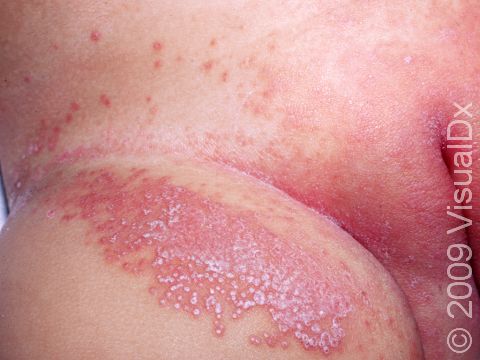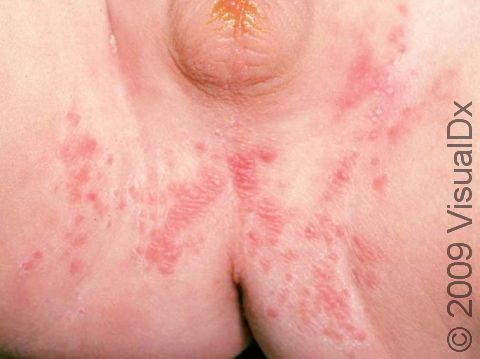Diaper Dermatitis (Candidiasis)
Candida albicans is a type of fungus normally found in the digestive (gastrointestinal) tract. If your baby is wearing a moist or blocked up (occluded) diaper, particularly one that is dirty (has fecal contamination), an inflammatory skin rash (dermatitis) may develop on the baby’s skin. Diarrhea increases the risk for developing candidal diaper dermatitis, and candida infection in the mouth (oral thrush) may also occur.
Who's At Risk?
Diaper dermatitis is one of the most common skin conditions in infants and children. Candidal diaper dermatitis is the second most common type of diaper dermatitis, with noninfected areas of redness and tenderness (irritant diaper dermatitis) being the most common type.
Signs & Symptoms
- Candidal diaper dermatitis most commonly appears in the genitals and diaper area, particularly the deep folds, and it consists of red elevated areas (papules) and flat, solid areas of skin (plaques) with sharp edges and skin flakes (scale) as well as surrounding “satellite” skin elevations containing pus (pustules).
- Redness (erythema) may appear to be joined into one area (confluent).
- Breakdown (erosions) or loss of the upper layer of skin may be present.
- Alternatively, the lesions may be merging together (coalescing) small pink bumps with overlying scale, without any redness.
Self-Care Guidelines
- Keep the diaper open as much as possible while the infant sleeps to allow drying of the skin.
- Use barrier ointments such as zinc oxide paste or petrolatum (Vaseline®) with diaper changes.
- Gently cleanse the diaper area with plain water or mild soap.
- Be sure to change your baby’s diapers, using disposable diapers.
Treatments
Topical therapies, applied twice a day:
- Nystatin cream
- Econazole cream
- Miconazole cream
- Clotrimazole cream
The doctor may also reassure you that once your baby is toilet trained, the diaper dermatitis will no longer develop.
Visit Urgency
See your baby’s doctor or a dermatologist for evaluation if your baby’s diaper dermatitis does not improve with self-care measures.
Trusted Links
References
Bolognia, Jean L., ed. Dermatology, pp.1186. New York: Mosby, 2003.
Freedberg, Irwin M., ed. Fitzpatrick’s Dermatology in General Medicine. 6th ed. pp.1373-1374, 2010-2011. New York: McGraw-Hill, 2003.
Last modified on October 5th, 2022 at 7:20 pm

Not sure what to look for?
Try our new Rash and Skin Condition Finder

